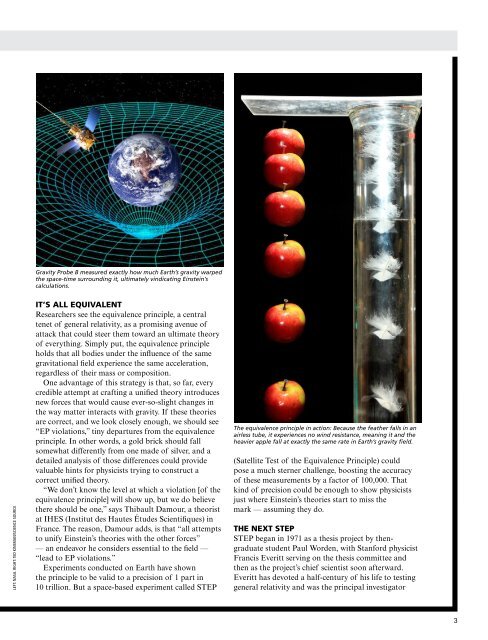GRAVITATIONAL WAVES
DIG-ASY-PRM_GravWavesFIN
DIG-ASY-PRM_GravWavesFIN
You also want an ePaper? Increase the reach of your titles
YUMPU automatically turns print PDFs into web optimized ePapers that Google loves.
Gravity Probe B measured exactly how much Earth’s gravity warped<br />
the space-time surrounding it, ultimately vindicating Einstein’s<br />
calculations.<br />
LEFT: NASA. RIGHT: TED KINSMAN/SCIENCE SOURCE<br />
IT’S ALL EQUIVALENT<br />
Researchers see the equivalence principle, a central<br />
tenet of general relativity, as a promising avenue of<br />
attack that could steer them toward an ultimate theory<br />
of everything. Simply put, the equivalence principle<br />
holds that all bodies under the influence of the same<br />
gravitational field experience the same acceleration,<br />
regardless of their mass or composition.<br />
One advantage of this strategy is that, so far, every<br />
credible attempt at crafting a unified theory introduces<br />
new forces that would cause ever-so-slight changes in<br />
the way matter interacts with gravity. If these theories<br />
are correct, and we look closely enough, we should see<br />
“EP violations,” tiny departures from the equivalence<br />
principle. In other words, a gold brick should fall<br />
somewhat differently from one made of silver, and a<br />
detailed analysis of those differences could provide<br />
valuable hints for physicists trying to construct a<br />
correct unified theory.<br />
“We don’t know the level at which a violation [of the<br />
equivalence principle] will show up, but we do believe<br />
there should be one,” says Thibault Damour, a theorist<br />
at IHES (Institut des Hautes Études Scientifiques) in<br />
France. The reason, Damour adds, is that “all attempts<br />
to unify Einstein’s theories with the other forces”<br />
— an endeavor he considers essential to the field —<br />
“lead to EP violations.”<br />
Experiments conducted on Earth have shown<br />
the principle to be valid to a precision of 1 part in<br />
10 trillion. But a space-based experiment called STEP<br />
The equivalence principle in action: Because the feather falls in an<br />
airless tube, it experiences no wind resistance, meaning it and the<br />
heavier apple fall at exactly the same rate in Earth’s gravity field.<br />
(Satellite Test of the Equivalence Principle) could<br />
pose a much sterner challenge, boosting the accuracy<br />
of these measurements by a factor of 100,000. That<br />
kind of precision could be enough to show physicists<br />
just where Einstein’s theories start to miss the<br />
mark — assuming they do.<br />
THE NEXT STEP<br />
STEP began in 1971 as a thesis project by thengraduate<br />
student Paul Worden, with Stanford physicist<br />
Francis Everitt serving on the thesis committee and<br />
then as the project’s chief scientist soon afterward.<br />
Everitt has devoted a half-century of his life to testing<br />
general relativity and was the principal investigator<br />
3


